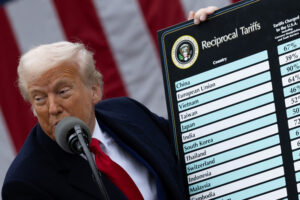By John Victor D. Ordoñez, Reporter
THE GOVERNMENT should seek new trade agreements with its regional and global partners to sustain its electronics, textiles and food industries after the US imposed a 17% tariff on the Philippines, economists said.
“Mitigating the impact of the tariffs requires proactive government action such as negotiating exemptions for critical industries and enhancing trade and investment agreements with other partners in the Association of Southeast Asian Nations, the European Union,” Philippine Institute for Development Studies Senior Research Fellow John Paolo R. Rivera said via Viber.
The White House said the Philippines will be charged a 17% “discounted reciprocal tariff,” in response to Philippine tariffs of 34% on US goods, as estimated by US trade officials.
Finance Secretary Ralph G. Recto has called the Philippines “relatively resilient” during trade wars due to its economy being driven by domestic demand.
Last week, US President Donald J. Trump announced a 10% baseline tariff on all its trading partners, with the rates set higher for countries that impose high tariffs on US goods.
Within Southeast Asia, the Philippines had the second lowest tariff next to Singapore, which was granted the 10% baseline tariff. Cambodia faces the steepest tariff at 49%, followed by Laos (48%), Vietnam (46%), Myanmar (45%), Thailand (37%), Indonesia (32%), Malaysia (24%) and Brunei (24%).
Presidential Communications Office Undersecretary Clarissa A. Castro said at a briefing on Thursday that countries facing higher tariffs could choose to set up shop in the Philippines and use it as an export base, leveraging the advantageous tariffs.
“The country should now look at new partners instead of simply allowing business as usual,” Leonardo A. Lanzona, who teaches economics at the Ateneo de Manila, said via Facebook Messenger.
He added that ”tariffs create uncertainty in world trade. How long will this regime hold?”
Agriculture Secretary Francisco P. Tiu Laurel, Jr. has said the Philippines could take advantage of the relatively lower tariff rate compared with its neighbors to “push for more sales to the US of our products.”
“Nonetheless, the Philippines should look at this as an opportunity for better competition versus comparable nations which had been slapped with higher tariffs by the US,” Terry L. Ridon, a public investment analyst and convenor of the InfraWatch PH think tank, said via Facebook Messenger.
He said the tariffs could make Philippine semiconductor and agriculture products more price competitive in the US.
Philippine exports to the US amounted to $12.4 billion last year, 53% or $6.43 billion of which were electronic products.
The US goods trade deficit with the Philippines was $4.9 billion in 2024, up 21.8% from a year earlier.
Calixto V. Chikiamco, Foundation for Economic Freedom president, said higher tariffs on countries like Vietnam and Thailand could prompt companies shipping to the US to relocate to the Philippines due to the relatively lower tariff of goods originating from the Philippines.
“Whatever disadvantages we have in infrastructure can be offset by the lower tariffs slapped on our export manufactures compared to neighboring countries,” he said via Viber.

